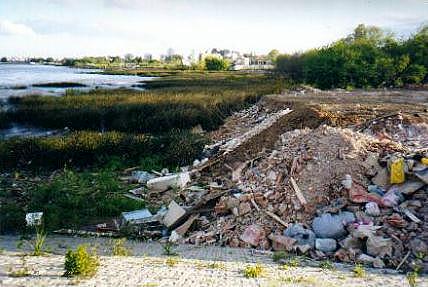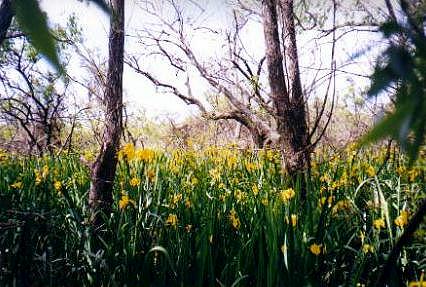|
Some
of the Conservation Problems that the Reserve faces:
- Many invasive plants
from other corners of the world are invading the reserve. Notably Yellow
Irises, which are replacing the natural vegetation of the long-grass
marshes (reeds and rushes). This is the dwelling place of the secluded
Curve-billed Reedhaunter (Linmornis curvirostris) and the
wonderfully coloured Scarlet-Headed Blackbird (Amblyramphus holosericeus).
If the Iris is not controlled, I fear these two species will not be
seen here much longer. Also two species of Privet (Ligustrum)
from Asia grow uncontrolled and are replacing bushes and plants in many
parts of the reserve. See photo below.
- The recent destruction
of nearby coastal habitats, now occupied by riverside restaurants and
sports centres, has impacted the population of birds and other animals.
They now depend much more on the small reserve. The Yellow-winged Blackbird
(Agelaius thilius), so common here till 1998, and that used to
breed and find refuge in the reeds all along the cost, is now a rarity.
The same goes for the Shag (Phalacrocoras olivaceus). Other coastal
areas have or will be "recycled" into "public access parks", so natural
vegetation is being cut in order to be replaced with cement, lawns and
exotic trees (set in straight lines!) which are considered by many as
"better" that the native species.
- When high tides
occur, rubbish is dumped by the river onto the grounds. It consists
mainly of plastic bottles, expanded styrofoam, plastic bags, etc., mixed
in with cut reeds, floating twigs, etc. The presence of this rubbish
exposes a serious waste management problem of the Greater Buenos Aires
area, and also reveals inconsiderate littering by the population and
weekend boaters. All this rubbish is "kept at bay" by the permanent
effort of the volunteers. Most of it is taken out, but you may see a
torn plastic bag hanging from a low branch here and there. So this problem
is more aesthetic than a real conservation problem. The guided tours
address this topic, and show it in an attempt to create awareness of
this issue to the visitors doing the guided tour. [Read
more about this]
- River contaminated
by industry chemicals, fertilisers spill from farms upstream, etc.
- Noise pollution.
A rubber dinghy fitted with hang-glider wings and a motor often used
to fly above, just off the coastal limits of the reserve, taking people
on "ecological" sight-seeing tours from the air. It was horrendous at
times! Fortunately this has not been seen since 2001. Airliners and
helicopters pass above from time to time, but is not a serious problem.
Motorboat noise from the river sometimes is heard.
- Stray dogs enter
the grounds and have caused problems with the Coipu population.
- The ever-present
risk that the community may choose to "develop" the area, or assign
other uses to the land, most notably coastal landfills, a riverside
highway, which would imply the loss of the reserve.
Below are a couple of photos
about these issues:

Destruction of the
coastal reedbeds (Giant Bulrush - Schoenoplectus californicus)
in nearby La Lucila (next to the
American-community's Lincoln School), about 1 or 2 miles south of Ribera
Norte. This landfill occurred in 1999.
The spot from where the photo was taken has now become a protected area,
but has no reeds of its own!
The reedbeds seen above are NOT protected, and in fact misguided council
projects intended to
"make the riverside more accessible to the people" are leading to their
destruction.
Photographed by Alec Earnshaw - 1999

Irises. These lovely flowers (Yellow Water Flags - Iris
pseudacorus L.) decorate much of the area in the Spring. However,
this species is a serious invader and is replacing the native rushes at
an alarming rate, and in time it may force native birds - such as the
rare Scarlet-headed Blackbird - to abandon the premises.
The Irises must be eradicated, but it's not an easy task!
Photographed at Ribera Norte by Alec Earnshaw - November
1999
|

